Adagio in G Minor, BWV 1001
A Look at the Structure (Part One)
By: Heather DeRome, with thanks to Frank Koonce.
This article is essentially a written version of the video (Adagio in G Minor, Part-one, Tutorial), linked on the right, but more in depth. It is intended for those who prefer to read rather than to watch a video, and it allows readers to study the score, which, although shown in the video, may go by too fast for some viewers.
The Adagio, BWV 1001, as mentioned in the performance notes of our edition of the Sonatas and Partitas, is in two main sections. The first section, from measures 1 to 9, modulates from G-minor to D-minor; and the last section, from measures 14 to 21, is an elaborated transposition, modulating from C-minor back to G-minor. (There is a transition section, which is discussed in Part-two.) This article will show in detail how the first and last sections match up and, perhaps more interestingly, will discuss those few instances in which Bach did not transpose the measures exactly. The video is recommended along with this article, because the corresponding measures are played back-to-back, and so you will be able to listen to how these measures relate, while following the score.
Comparing measures 1 and 14, we see that the bass is transposed exactly (the melodic C on the downbeat of measure 14 functions as a bass note as well). In measure 1, the opening chord, which is also the opening chord of the whole set of Sonatas and Partitas, will of course be a grander gesture than one in the middle of a movement. The second beats in both measures feature descending lines. At beat three, the chords in both have the same intervallic structure: Measure 1 has A/G/C and measure 14 has D/C/F. Both are viiº6 with 4-3 appoggiaturas, being G to F-sharp in measure 1, and the C to B-natural in measure 14. The last beats are identical.
 ');"
');"
Comparing measures 2 and 15, again the bass is exactly transposed. At the second beats, measure 15 is a variation of measure 2: Measure 2 has a decorated C followed by the drop of a fourth from D to A, and measure 15 has a decorated F followed by the drop of a fourth from G to D. Beats 3 and 4 match exactly.

Comparing measures 3 and 16, again the bass lines are transposed repeats, as is much of the upper part. Beats 1 match; beats 3 and the first halves of beats 4 are variations of each other, and the ends of the measures match exactly.
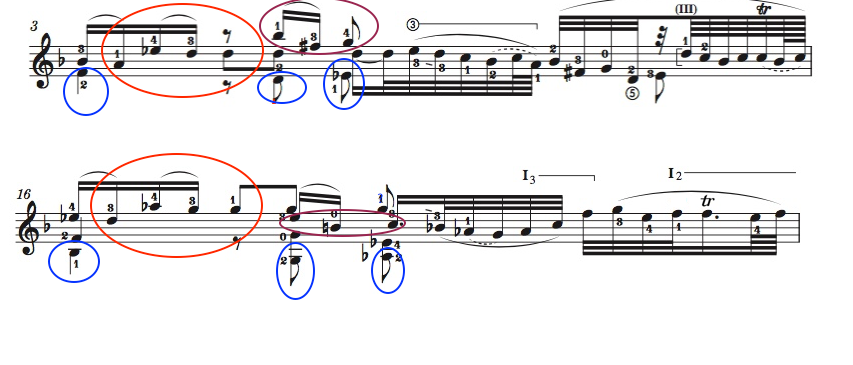
Comparing measures 4 and 17, the upper parts match, although the soprano and alto parts are inverted in the first beats. The bass, however, shows a variance at the end of beats 2. The encircled F-sharp is not Bach’s note, but one that was added in our edition. Bach’s B is the first bass note that does not represent an exact transposition of its analogous measure, and so we must ask ourselves: “Why?” Measure 4 would require F-sharp to correspond to Bach’s B in measure 17; however, that note is not playable on the violin, which has G as its lowest note.
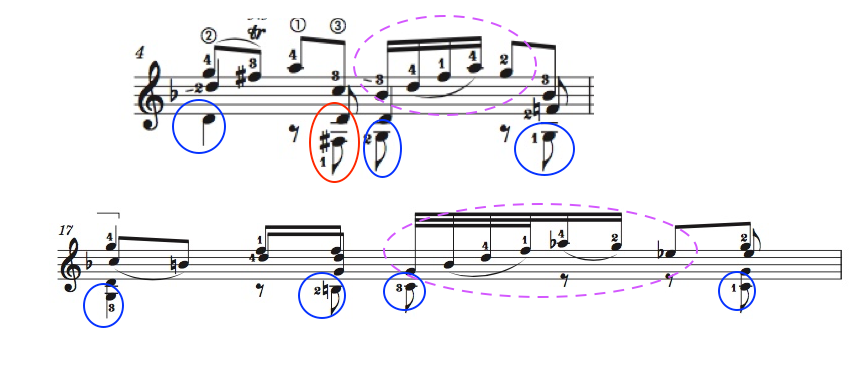
Comparing measures 5 and 18, again the basses match, as does much of the upper part. Measure 18 is quite elaborated in the early part of the measure; this is typical when approaching a final cadence.
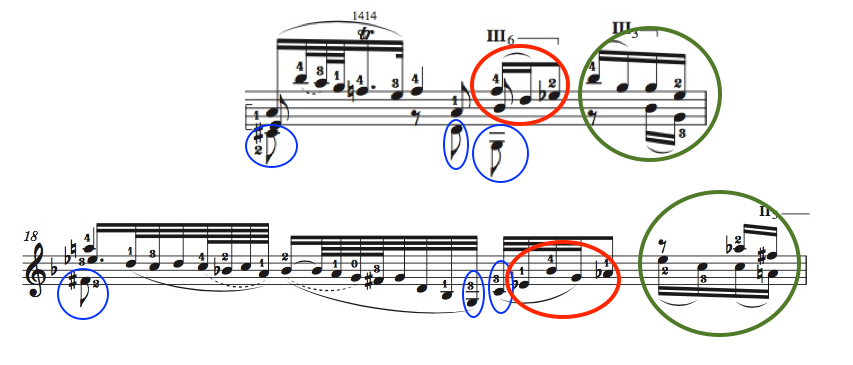
Comparing measures 6 and 19, again there is a discrepancy in the bass part. For the violin in measure 6, there is a stepwise descent. The downbeat chord is A/C#/E-flat/G (with the G as the bass), resolving to F as part of a D-minor chord in first inversion––a typical, V4-2 to 1-6 resolution. Both in measures 6 and 19, the interval between the two downbeat notes is a minor 6th. Looking at measure 19, Bach does not have the chordal 7th in the bass, although the second chord, G-minor in first inversion, is there, and the descending bass line is almost there too. Adding C at the downbeat of measure 19 gives it the same function as that of measure 6, and also allows for the transposed bass line. Therefore, in our arrangement we have added that note.
Again, we must ask ourselves why Bach himself had not added the C. Here, we believe the answer has to do with violin technique. The chord C/A/F# is awkward on the violin for the left hand. It also requires a shift up the neck, and the baroque violin was mostly played in the lower positions, usually first position.
Stepping aside for a glimpse into the historical reasons for this, the early violin was not held in place by the chin as it is today, but was lightly held in the left hand. Now, if the hand that is holding the violin makes a quick movement, it will tend to take the instrument with it. For upward shifts, this movement was counteracted by the chest, as the violin simply was being pushed in towards the body. But what of downward shifts? With nothing to hold it in place, the left hand would simply throw the instrument, out and away from the body. Because of this, later composers, and possibly Bach as well, wrote music in which downward shifts had many steps, so that, in essence, the left hand could incrementally "crawl" down the neck.
Comparing the remainder of measures 6 and 19, we can see that the notes are identically transposed. However, notice that the slurs differ in the last beats. Guitarists can articulate those two beats differently, just as can a violinist.
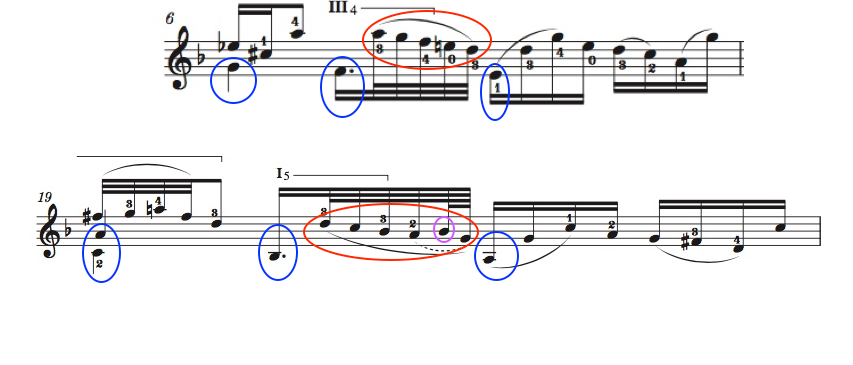
Measures 7 and 20 contain some wonderful writing.
The way Bach deals with the approaches to his important cadence, both to D-minor and to the final cadence, reveals once again that we are in the presence of a creative genius. Although, in essence, measure 20 is indeed a transposition of measure 7, Bach still deals with these two passages differently. ––and masterfully. First, looking at how measure 20 is simply transposed, the functional chords almost match. Again, when sections don't quite match, it is always fascinating to examine them closely to see if we might find reasons for the discrepancies. Measure 7 has the chords D-minor, G-minor and E-diminished, while measure 20 matches with the first two chords, G-minor and C-minor, but then––instead of having A-diminished––Bach goes to A-flat. And really, it would be more correct to cross out the C-minor and to call the last two beats all A-flat in first inversion (C/A-flat/E-flat). Therefore, the C-minor at beat 3 serves a dual function: first it fulfills the expectation that the chords are exactly transposed. But soon after, it becomes clear that this really is part of the beat-four A-flat chord, and that the C and E-flat are the third and fifth of the Neapolitan chord. Typically, and as is the case here, the Neapolitan 6th chord is used to hail an important cadence, usually the final cadence. Bach assumes his listeners will be expecting not A-flat, but A-diminished, and then by giving them the Neapolitan, A-flat, instead it surprises them a little, and alerts them that the end is drawing near.
Looking now at how Bach creates a sense of expectancy as he approaches the cadence in measures 7-8: At beat 1, he has a D-minor chord; the bass moves down by step and the chord becomes D-minor 7, and this resolves to G-minor in first inversion. This is standard writing. But notice how Bach creates motion and tension: Even though the C and A at the end of beat two form the consonant interval of the sixth, that C is the dissonant 7th in the D-minor 7 chord, and so it wants to resolve to B-flat in a G-minor chord in first inversion. A sensitive musician will feel that pull. And then, rather than resolving it right away, Bach repeats the upper note A as an appoggiatura above the B-flat which creates a striking dissonance with the crunch of a major 7th. The A then really does resolve two notes later, to G. This is followed by a diminished chord, which again has a strong feeling of unrest, and then a full measure of the dominant 7th (notice how the 7th is introduced in the alto voice and is then swept up into the soprano) before finally really resolving at D minor. It is such a masterful use of the simple i-iv-iiº-V7-i progression!
Looking at the bass voice, the descending line from measure 7 is not transposed in measure 20. In measures 7-8, Bach has a line going down by step to the dominant, but in measures 20-21, the line begins on the violin’s lowest note and then goes up by step to the dominant.

Looking a little further at the comparison between the bass lines at the downbeats of measures 8 and 21, measure 8 has A and measure 21 has C (a transposition from A would have been D). For those of us who have studied functional harmony, we were taught that the Neapolitan chord resolves with the bass moving up by step from the fourth to the fifth scale degrees (in our case it would be C going to D). However, this is not how Bach typically resolves these chords. Rather, he usually keeps the fourth scale degree (in this case, C) in the bass; this then becomes the 7th of a V7 chord (here the 7th of D7), and then typically resolves it by falling to the third of the next chord (here that would be B-flat in a G-minor chord). However, in this instance, Bach passes through C-sharp to get to the dominant D (and so in a way he is foreshadowing a later development insofar as how the chord was resolved).
Comparing the third and fourth beats of measures 8 and 21, again measure 21 is similar but more elaborate: The upper line moves much in the same way as it did in measure 8, but with faster notes. In measure 9, the arrival at D-minor is quite soft, a simple octave double stop on the two inner strings; in measure 22, however, the final chord is louder, arpeggiating across all the strings, and requiring a large movement with the bowing arm, as the bow sweeps up through much of the range of the instrument.
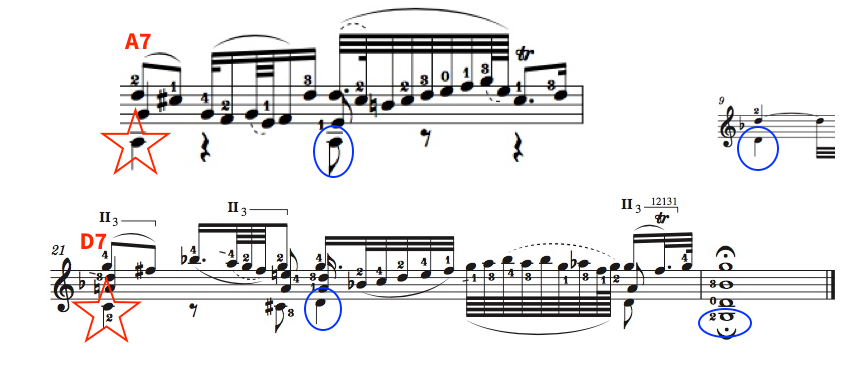
Please see part-two of this article, which discusses the transition section, from measures nine to fourteen.
Copyright Koonce/DeRome, 2019. All rights reserved.
The Adagio, BWV 1001, as mentioned in the performance notes of our edition of the Sonatas and Partitas, is in two main sections. The first section, from measures 1 to 9, modulates from G-minor to D-minor; and the last section, from measures 14 to 21, is an elaborated transposition, modulating from C-minor back to G-minor. (There is a transition section, which is discussed in Part-two.) This article will show in detail how the first and last sections match up and, perhaps more interestingly, will discuss those few instances in which Bach did not transpose the measures exactly. The video is recommended along with this article, because the corresponding measures are played back-to-back, and so you will be able to listen to how these measures relate, while following the score.
Comparing measures 1 and 14, we see that the bass is transposed exactly (the melodic C on the downbeat of measure 14 functions as a bass note as well). In measure 1, the opening chord, which is also the opening chord of the whole set of Sonatas and Partitas, will of course be a grander gesture than one in the middle of a movement. The second beats in both measures feature descending lines. At beat three, the chords in both have the same intervallic structure: Measure 1 has A/G/C and measure 14 has D/C/F. Both are viiº6 with 4-3 appoggiaturas, being G to F-sharp in measure 1, and the C to B-natural in measure 14. The last beats are identical.

Comparing measures 2 and 15, again the bass is exactly transposed. At the second beats, measure 15 is a variation of measure 2: Measure 2 has a decorated C followed by the drop of a fourth from D to A, and measure 15 has a decorated F followed by the drop of a fourth from G to D. Beats 3 and 4 match exactly.

Comparing measures 3 and 16, again the bass lines are transposed repeats, as is much of the upper part. Beats 1 match; beats 3 and the first halves of beats 4 are variations of each other, and the ends of the measures match exactly.

Comparing measures 4 and 17, the upper parts match, although the soprano and alto parts are inverted in the first beats. The bass, however, shows a variance at the end of beats 2. The encircled F-sharp is not Bach’s note, but one that was added in our edition. Bach’s B is the first bass note that does not represent an exact transposition of its analogous measure, and so we must ask ourselves: “Why?” Measure 4 would require F-sharp to correspond to Bach’s B in measure 17; however, that note is not playable on the violin, which has G as its lowest note.

Comparing measures 5 and 18, again the basses match, as does much of the upper part. Measure 18 is quite elaborated in the early part of the measure; this is typical when approaching a final cadence.

Comparing measures 6 and 19, again there is a discrepancy in the bass part. For the violin in measure 6, there is a stepwise descent. The downbeat chord is A/C#/E-flat/G (with the G as the bass), resolving to F as part of a D-minor chord in first inversion––a typical, V4-2 to 1-6 resolution. Both in measures 6 and 19, the interval between the two downbeat notes is a minor 6th. Looking at measure 19, Bach does not have the chordal 7th in the bass, although the second chord, G-minor in first inversion, is there, and the descending bass line is almost there too. Adding C at the downbeat of measure 19 gives it the same function as that of measure 6, and also allows for the transposed bass line. Therefore, in our arrangement we have added that note.
Again, we must ask ourselves why Bach himself had not added the C. Here, we believe the answer has to do with violin technique. The chord C/A/F# is awkward on the violin for the left hand. It also requires a shift up the neck, and the baroque violin was mostly played in the lower positions, usually first position.
Stepping aside for a glimpse into the historical reasons for this, the early violin was not held in place by the chin as it is today, but was lightly held in the left hand. Now, if the hand that is holding the violin makes a quick movement, it will tend to take the instrument with it. For upward shifts, this movement was counteracted by the chest, as the violin simply was being pushed in towards the body. But what of downward shifts? With nothing to hold it in place, the left hand would simply throw the instrument, out and away from the body. Because of this, later composers, and possibly Bach as well, wrote music in which downward shifts had many steps, so that, in essence, the left hand could incrementally "crawl" down the neck.
Comparing the remainder of measures 6 and 19, we can see that the notes are identically transposed. However, notice that the slurs differ in the last beats. Guitarists can articulate those two beats differently, just as can a violinist.

Measures 7 and 20 contain some wonderful writing.
The way Bach deals with the approaches to his important cadence, both to D-minor and to the final cadence, reveals once again that we are in the presence of a creative genius. Although, in essence, measure 20 is indeed a transposition of measure 7, Bach still deals with these two passages differently. ––and masterfully. First, looking at how measure 20 is simply transposed, the functional chords almost match. Again, when sections don't quite match, it is always fascinating to examine them closely to see if we might find reasons for the discrepancies. Measure 7 has the chords D-minor, G-minor and E-diminished, while measure 20 matches with the first two chords, G-minor and C-minor, but then––instead of having A-diminished––Bach goes to A-flat. And really, it would be more correct to cross out the C-minor and to call the last two beats all A-flat in first inversion (C/A-flat/E-flat). Therefore, the C-minor at beat 3 serves a dual function: first it fulfills the expectation that the chords are exactly transposed. But soon after, it becomes clear that this really is part of the beat-four A-flat chord, and that the C and E-flat are the third and fifth of the Neapolitan chord. Typically, and as is the case here, the Neapolitan 6th chord is used to hail an important cadence, usually the final cadence. Bach assumes his listeners will be expecting not A-flat, but A-diminished, and then by giving them the Neapolitan, A-flat, instead it surprises them a little, and alerts them that the end is drawing near.
Looking now at how Bach creates a sense of expectancy as he approaches the cadence in measures 7-8: At beat 1, he has a D-minor chord; the bass moves down by step and the chord becomes D-minor 7, and this resolves to G-minor in first inversion. This is standard writing. But notice how Bach creates motion and tension: Even though the C and A at the end of beat two form the consonant interval of the sixth, that C is the dissonant 7th in the D-minor 7 chord, and so it wants to resolve to B-flat in a G-minor chord in first inversion. A sensitive musician will feel that pull. And then, rather than resolving it right away, Bach repeats the upper note A as an appoggiatura above the B-flat which creates a striking dissonance with the crunch of a major 7th. The A then really does resolve two notes later, to G. This is followed by a diminished chord, which again has a strong feeling of unrest, and then a full measure of the dominant 7th (notice how the 7th is introduced in the alto voice and is then swept up into the soprano) before finally really resolving at D minor. It is such a masterful use of the simple i-iv-iiº-V7-i progression!
Looking at the bass voice, the descending line from measure 7 is not transposed in measure 20. In measures 7-8, Bach has a line going down by step to the dominant, but in measures 20-21, the line begins on the violin’s lowest note and then goes up by step to the dominant.

Looking a little further at the comparison between the bass lines at the downbeats of measures 8 and 21, measure 8 has A and measure 21 has C (a transposition from A would have been D). For those of us who have studied functional harmony, we were taught that the Neapolitan chord resolves with the bass moving up by step from the fourth to the fifth scale degrees (in our case it would be C going to D). However, this is not how Bach typically resolves these chords. Rather, he usually keeps the fourth scale degree (in this case, C) in the bass; this then becomes the 7th of a V7 chord (here the 7th of D7), and then typically resolves it by falling to the third of the next chord (here that would be B-flat in a G-minor chord). However, in this instance, Bach passes through C-sharp to get to the dominant D (and so in a way he is foreshadowing a later development insofar as how the chord was resolved).
Comparing the third and fourth beats of measures 8 and 21, again measure 21 is similar but more elaborate: The upper line moves much in the same way as it did in measure 8, but with faster notes. In measure 9, the arrival at D-minor is quite soft, a simple octave double stop on the two inner strings; in measure 22, however, the final chord is louder, arpeggiating across all the strings, and requiring a large movement with the bowing arm, as the bow sweeps up through much of the range of the instrument.

Please see part-two of this article, which discusses the transition section, from measures nine to fourteen.
Copyright Koonce/DeRome, 2019. All rights reserved.

 Videos
Videos Articles
Articles Adagio in G Minor, BWV 1001
Adagio in G Minor, BWV 1001